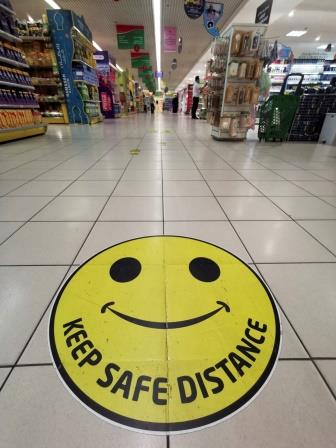(World) – They range from simple spray-painted circles on the ground in a Mogadishu market to bright and breezy floor stickers in a Dubai mall, which blow a kiss and urge: “Hey there beautiful, don’t forget to keep a safe distance.”
The markings that will oblige us to keep apart in busy social settings, in order to prevent transmission of the new coronavirus, are appearing on shop floors, city pavements and train or tram platforms the world over.
As people emerge from weeks of lockdown, they face an array of new measures to try and keep the virus in check and protect society’s most vulnerable.
The signs mounted so far went up at speed – but look likely to become commonplace and could be in use for years.
Dots on the ground, lines, squares within squares, love hearts and smiley faces are being used around the world. The markings need to be impactful enough to be adhered to, but also, ideally, to reassure people without making them feel cattle-driven.
“Anywhere where there are graphics at the moment, it is because people have had to react super quick and put something in place – speed has been of the essence. We are now at the point where there is a bit of breathing space,” said Chris Girling, Head of Wayfinding at CCD Design & Ergonomics in London.
We have a hotchpotch of styles, colours, terminology, scale and placement strategies, he notes. “This means every single time a member of the public enters a different space they are having to relearn the rules.”
There is a balance to be found, he said. “People want to feel safe, reassured and at ease. If you can do that, they are in turn going to be more likely to shop, feel relaxed and return. The message needs to be clear and consistent … and absorbed.”
PLEASE
Levels of politeness vary in the places where retailers, city and transport authorities have been able to afford to print special signs.
“For your safety please stand 2 metres from other people,” reads a floor sign in a Shell petrol garage in Britain.
“Please practice social distancing,” reads another alongside footprints in Santa Monica, California.
“Stand here” is written in English on a red circle floor sign in a grocery shop in Beirut.
“If we are using words like ‘stop’ and ‘go’ and more abrupt language, then that is more associated with hazard and prohibitive signage. This (COVID-19) is a very different type of situation and one that people have never experienced before, so it warrants a different tone of voice,” said Girling.
“It is definitely worth trying a more friendly and inventive touch with how you talk to your customers or the general public as they are likely to be more receptive… there is even a bit of space for humour.”
Footprints have proved popular so far, in signs from Bury in Britain to Abidjan in Ivory Coast, but as Girling points out, the best sign systems would also encourage linear movement and give a visual understanding of direction.
Asked how he would design a social distancing system, he suggested a line of tape to show a pathway, which changes colour every two metres.
“The instinct to follow a line from childhood naturally stays the same as we become adults, and you subconsciously pick up on these visual cues as you walk around environments.”
Signs related to COVID-19 should also ideally have their own distinctive colour, which will become instantly recognisable.
(Photos syndicated via Reuters)













